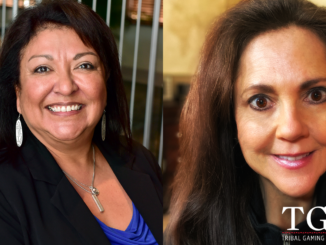Interview with Steve Browne and Janet Hawk
One of the most important skills of a casino host is how to introduce yourself properly and effectively to a new or existing guest (also known in the industry as “cutting-into”). In this interview TG&H chats with longtime industry educators and casino executives, Janet Hawk and Steve Browne. In these articles we’re going to be talking about different aspects of building a better host department specifically to training. We’re going to cover some of those aspects of the jobs that new hosts may have a lot of resistance to doing.
TG&H: Steve, when you think about training someone who might be new to hosting, but who has worked in the loyalty club, how long does it take a host to get up to speed that can either start developing their own book of business or can be handed over an existing one?
SB: That depends on a lot of factors, including their current knowledge level of the property, (operations and amenities), their interpersonal and service skills, technological savvy, and, of course, sales training including basic sales skills and mathematical sales metrics. It also depends on how long the organization is willing to invest in start-up training.
Many companies want employees to be up and running as soon as possible, while the better ones (in my opinion) are willing to take their time to train and develop team members in their particular skill sets. I would say it would take a minimum of a few weeks up to several months (months?). Yes… months. Why so long? Because I want them to shadow every department they are not familiar with, including Slots, Tables, Cage, Hotel, F& B And Marketing. Sales skills training should take at least a week of intensive classroom and study (that’s about how long our programs last). And some quality time shadowing and being mentored by an existing (and exceptional) property host. Give me two to three months to accomplish all of that and I will have them up and running.
TG&H: Janet, when it comes to learning how to “cut-in,” where does this rank compared to other skills that some hosts might find challenging at first (cold calling, downgrading a player, etc.?) Is it one of the first or last skills that is taught?
JH: This is one of the very first skills we teach anyone in PD. This is what they will do every day and it is imperative that they learn when to cut in and, most importantly, when NOT to cut in. Steve already touched on it, but the biggest mistake made with PD teams is that they don’t train their teams. They mostly teach them the basics of how the system they use works and then set them loose. Hosts are an elite sales team and need to be trained on the many aspects of their job. This includes how to develop business relationships with guests (both internal and external), how to be professional in business, getting them comfortable with contacting new people, effective communication and listening skills, time management, etc. The reason most hosts & PD teams don’t succeed is because no one invests the appropriate amount of time in training them. When hosts aren’t trained, they naturally become “huggers” to only people they feel comfortable with (we call them the “usual suspects”). They don’t drive trips, they just become order takers. Player Development is a revenue-generating department when the team is trained properly.
TG&H: Steve, is there a different approach for table games versus slot players for cutting-in?
SB: Absolutely. The dynamics of the pit as opposed to the slot floor mean a different set of parameters must be included in the training. The fundamentals remain the same. But the situational requirements of the different environments demand different approaches. Working table game players involves intimate knowledge of the dynamics of a pit operation. The slot floor is more open and accessible and the time to cut-in is simpler (tables requires a good knowledge of game flow to understand when and where to cut-in to a table games player.
TG&H: Steve, do most Tribal casinos have player-tracking technology (hot player screens, active player coin-in, etc.) to prioritize which active players to cut into first? And if not, how do you do this?
SB: Yes, just about every system out there has some type of technology that allows you to prioritize who to target. Old school techniques that do not depend on technology include gaming area coverage (high-limit), other VIP areas (fine-dining, VIP lounges and show seating), monitoring play patterns in the pit, and reviewing machines for high dollar play. And don’t forget that old standby… existing player and fellow associate referrals.
TG&H: Janet, can you list the “don’ts” of cutting-in and what is the most common mistake in this list that new hosts make?
- Never approach a player who is obviously losing, upset, or just doesn’t want to be bothered. Remember, service is always on the players terms.
- Do not exclude other players on the same game or in the same area. You never know who you might find!
- Why would you never say, “Do you want to have your play tracked?” Getting a guest to play with a card is how we can determine to reinvest in our guests properly. Demonstrating the benefits and overcoming objections is a skill each host needs to learn.
- Never send a new player anywhere, always offer to go there yourself (sign up, make reservation, etc.).
- Never badmouth any aspect of your casino/hotel, badmouth a competitor, or recommend a competitor’s facilities or services. Again, this is professionalism in business.
- Never ignore the new guest’s spouse or significant other. It isn’t always about the player. Sometimes, building the player’s profile will include learning about the spouse of significant other who DOESN’T gamble.
TG&H: Steve, tell us about the “do’s” of cutting-in and if they forget everything on this list, what is the one thing you’d like a new host to remember?
Steve:
- Always be able to immediately act on behalf of the player you are cutting into.
- Always leave the guest feeling good.
- Always be aware of what point of the game you are approaching an active player.
- Always use the potential new player’s name (if known).
- Always remember the power of offering the “free” or the “little” things (getting information, expediting drink service, giving a promotional tchotchke, etc.).
- Always build relationships with other gaming team members to refer to you new players that they encounter.
- Always hand out a (colorful, sales oriented) business card at the close of an interaction with a new player.
- Always follow up with a return interaction with a new guest, and later, if possible, a “Nice to meet you, welcome to the club,” direct mail piece, personally signed.
In our next article with Steve and Janet, we’ll be talking about the art of “cold calls” and mastering asking for a visit without giving away anything.
Does your Host and PD program need a revamp? Maybe your “elite” host team needs some custom training? To find out more about Raving’s Host and PD programs, please contact Kristine Woods at Kristine@betravingknows.com or call 775-329-7864.




